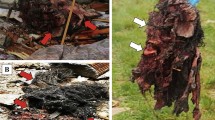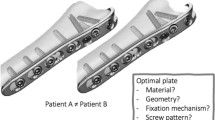Abstract
Determining the time of injury is an important but still a challenging task in forensic anthropology. In literature, many descriptions can be found to make a distinction between perimortem and postmortem fractures. Characteristics that are more related to fractures in fresh conditions, however, are not extensively investigated. This study compared 28 perimortem fractures from autopsies and 21 both fresh and dry experimentally reproduced human bone fractures. Preliminary results showed the following five distinct traits that might be related to perimortem conditions: layered breakage, bone scales, crushed margins, wave lines and flakes with matching flake defect. These distinct traits might not only be good estimators of perimortem trauma but also may be an indicator of trauma in intra vitam conditions, especially related with muscular reaction to injury. Furthermore, layered breakage seems to be a good trait to infer the biomechanics of trauma.







Similar content being viewed by others
References
Sauer NJ, Simson LR (1984) Clarifying the role of forensic anthropologists in death investigations. J Forensic Sci 29:1081–1086
Galtés I (2013) Estudio médico forense del cadáver en mal estado. In: Libro X Curso Patología Forense. Sociedad Española de Patología Forense, Logroño, pp. 113–141
Tersigni-Tarrant MA, Shirley NR (2013) Forensic anthropology today. In: Tersigni-Tarrant MA, Shirley NR (eds) Forensic Anthropology: An Introduction. CRC Press, Florida
Reichs KJ (1998) Forensic osteology: advances in the identification of human remains, 2nd Edition. Charles C Thomas, Springfield
Sauer NJ (1998) The timing of injuries and manner of death: distinguishing among antemortem, perimortem, and postmortem trauma. In: Reichs KJ (ed) Forensic osteology: advances in the identification of human remains. Charles C. Thomas, Springfield, pp. 321–332
Galloway A, Zephro L, Wedel VL (2014) Diagnostic criteria for the determination of timing and fracture mechanism. In: Wedel VL, Galloway A (eds) Broken bones. Charles C Thomas, Springfield, pp. 47–58
Dirkmaat DC (2012) A companion to forensic anthropology. Wiley-Blackwell, Oxford
Christensen AM, Passalacqua N V, Bartelink EJ (2014) Forensic anthropology: current methods and practice. Academic Press, Oxford
Symes SA, L’Abbé EN, Stull KE et al (2014) Chapter 13: taphonomy and the timing of bone fractures in trauma analysis. In: Pokines JT, Symes SA (eds) Manual of forensic taphonomy. CRC Press, Florida, pp. 341–365
Nawrocki S (2009) Forensic taphonomy. In: Blau S, Ubelaker DH (eds) Handbook of forensic anthropology and archaeology. Left Coast Press, Walnut Creek, pp. 284–295
Cappella A, Amadasi A, Castoldi E et al (2014) The difficult task of assessing perimortem and postmortem fractures on the skeleton: a blind text on 210 fractures of known origin. J Forensic Sci 59:1598–1601
Symes SA, L’Abbé EN, Chapman EN et al (2012) Chapter 17: interpreting traumatic injury to bone in medicolegal investigations. In: Dirkmaat DC (ed) A companion to forensic anthropology. Wiley-Blackwell, Oxford, pp. 340–388
Wedel VL, Galloway A (2014) Broken bones. Charles C. Thomas, Springfield
Symes SA, Rainwater MS, Chapman EN et al (2008) Patterned thermal destruction of human remains in a forensic setting. In: Schmidt CW, Symes SA (eds) Analysis of burned remains. Academic Press, Oxford, pp. 15–54
Ubelaker DH, Adams BJ (1995) Differentiation of perimortem and postmortem trauma using taphonomic indicators. J Forensic Sci 40:509–512
Wieberg DAM, Wescott DJ (2008) Estimating the timing of long bone fractures: correlation between the postmortem interval, bone moisture content, and blunt force trauma fracture characteristics. J Forensic Sci 53:1028–1034
Ortner D (2008) Differential diagnosis of skeletal injuries. In: Kimmerle EH, Baraybar JP (eds) Skeletal Trauma. CRC Press, Florida, pp. 21–93
Galloway A, Zephro L (2005) Chapter 8: skeletal trauma analysis of the lower extremity. In: Rich J, Dean DE, Powers RH (eds) Forensic medicine of the lower extremity: human identification and trauma analysis of the thigh, leg, and foot. Humana Press, New Jersey, pp. 253–277
Gozna ER (1982) Biomechanics of long bone injuries. In: Gozna ER, Harrington IJ (eds) Biomechanics of musculoskeletal injuries. Williams and Wilkins, Baltimore, MD, pp. 1–24
Tencer AF (2006) Biomechanics of fixation and fractures. In: Rockwood CA, Green DP, Bucholz RW, Heckman JD (eds) Rockwood Green’s fractures in adults, 6th edn. Lippincott-Raven, Philadelphia, pp. 3–42
Ebacher V, Tang C, McKay H et al (2007) Strain redistribution and cracking behavior of human bone during bending. Bone 40:1265–1275
Damkilde L (2000) Stress and stiffness analysis of beam-sections. Technical University of Denmark, http://homes.civil.aau.dk/lda/Notes/CROSS.pdf. Accessed 10 June 2015
Rouvière H, Delmas A (1988) Anatomia humana. Masson, Barcelona
Kieser J (2013) Biomechanics of bone and bony trauma. In: Kieser J, Taylor M, Carr D (eds) Forensic biomechanics. Wiley-Blackwell, Oxford, pp. 35–70
Etxeberria F (2003) Patología Traumática. In: Isidro Llorens A, Malgosa Morera A (eds) Paleopathologia: la enfermedad no escrita. Masson, Barcelona
Sen S, Ando T, Kobayashi E et al (2014) Development of femoral bone fracture model simulating muscular contraction force by pneumatic rubber actuator. Eng Med Biol Soc:6872–6875
Pick TP (1885) Fractures and dislocations. Lea Brothers & Company, Philadelphia
Porta DJ (2005) Chapter 9: biomechanics of impact injury. In: Rich J, Dean DE, Powers RH (eds) Forensic medicine of the lower extremity: human identification and trauma analysis of the thigh, leg, and foot. Humana Press, New Jersey, pp. 279–310
Kieser J, Taylor M, Carr D (2013) Forensic biomechanics. Wiley-Blackwell, Oxford
Botella MC, Aleman I, Jiménez SA (1999) Los huesos humanos, manipulación y alteraciones. Bellaterra, Barcelona
Moraitis K, Spiliopuolou C (2006) Identification and differential diagnosis of perimortem blunt force trauma in tubular long bones. Forensic Sci Med Pathol 2:221–229
Moraitis K, Eliopoulos C, Spiliopoulou C (2008) Fracture characteristics of perimortem trauma in skeletal material. Internet J Biol Anthropol 3:1–13
Acknowledgements
Special thanks go to the technicians and personnel staff of the Institut de Medicina Legal i Ciències Forenses de Catalunya (IMLCFC). The authors are grateful to Hannah McGlynn for the English language revision of the manuscript.
Author information
Authors and Affiliations
Corresponding author
Rights and permissions
About this article
Cite this article
Scheirs, S., Malgosa, A., Sanchez-Molina, D. et al. New insights in the analysis of blunt force trauma in human bones. Preliminary results. Int J Legal Med 131, 867–875 (2017). https://doi.org/10.1007/s00414-016-1514-1
Received:
Accepted:
Published:
Issue Date:
DOI: https://doi.org/10.1007/s00414-016-1514-1




